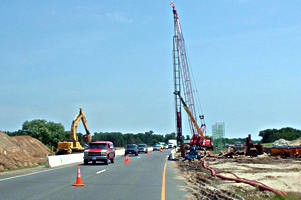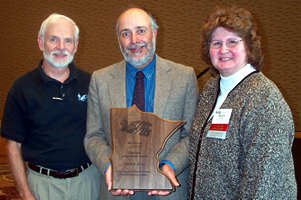 |
 |
|
 |
Record $1 billion, 246-project construction season winds down as winter nears
|
 |
 |
 |
Brainerd/District 3 staff (from left, Bob Busch, district engineer;
Paul Koenig, senior engineering specialist, and LuAnn Cameron, administrative
assistant) gather to review progress on building an interchange on Hwy
371 near Brainerd. The interchange eliminates a four-way stop at the
old Hwy 371/Business Hwy 371 intersection. Funding for the $68.3 million
project came from the special appropriation by the 2000 Legislature
for Moving Minnesota projects. Photo by Cathy Clark
|
We’ve all heard the old joke, "There are two seasons in Minnesota—winter
and road construction." Appropriately enough, as cold, snowy weather nears,
the construction season starts to wind down. Mn/DOT released a progress report
today on this year’s largest ever season with 246 major highway construction
projects completed or near completion statewide.
Investments statewide totaled more than $1 billion. Fifty percent of the funds
came from the federal government; fifty percent were appropriated by the Legislature.
"Thanks, in part, to the one-time funding granted by the Legislature in
2000, this was the largest construction season in state history," said
Doug Weiszhaar, acting commissioner. "As a result of the work we have accomplished
this summer, reconstructed and expanded highways, plus new tools in our traffic
management system, will improve safety and efficiency for tens of thousands
of drivers."
Weiszhaar said major projects that are complete, or, weather permitting, are
expected to be finished by the end of the construction season include:
Northern/Central Minnesota
-
Hwy 194 (Mesaba Avenue) in Duluth, reconstruction
-
Hwy 169 reconstruction of 34 miles expected to be completed by the end
of October
-
Hwy 23 from I-94 to Cold Spring, adding two lanes on 7.5 miles of roadway.
(Opening to four lanes this fall dependent on weather.)
-
Hwy 371 interchange completed Oct. 4, 2002, south of Brainerd
Northwestern Minnesota
-
Hwy 59 from the Grant County line to Barrett, road widened by seven feet
on each side, shoulder improvements.
-
Hwy 197 in Bemidji, highway reconstruction to four-lane divided highway
and bridge construction.
Twin Cities Metro Area
-
I-494 in Bloomington, rebuilding Penn Avenue interchange and bridge construction.
(Scheduled to open by Nov. 1.)
-
Hwy 77 (Cedar Avenue) bridge repair work over I-35E. Crews replaced expansion
joints, added a new concrete overlay on the bridge and completed shoulder
work and guardrail repair.
-
Hwy 7 from St. Bonifacius to Shorewood; adding new 12- foot shoulders,
turn lanes and signals. Set for completion in mid-November.
-
I-94 in Maple Grove, bridge and ramp replacement and widening
-
Hwy 169 (Ferry Street) reconstruction and widening from the Mississippi
River bridge to Hwy 10 in Anoka
Southern Minnesota
 |
Construction progresses on the Anoka County Road 52 (95th venue North)
bridge over I-35W in Blaine. The bridge and a new interchange will be
completed in November. Cost of the project is $13.5 million. Photo
by Kent Barnard
|
Significant improvements have also been made to Mn/DOT’ traffic management
systems. New advances include providing public viewing access to 238 traffic
cameras on Mn/DOT’s Web site. Images of traffic are updated every 60 seconds,
allowing Twin Cities drivers to make better-informed choices about their route
before they leave home or work.
Mn/DOT also completed implementation of a new ramp metering system. New sensors
on ramps monitor wait times at the same time the system provides more reliable
travel times by reducing delays caused by congestion and crashes. Click here
for more information about the Web
traffic cameras.
"With the end of the construction season and the beginning of the snow
and ice season, providing up-to-the-minute traveler information remains a top
priority for Mn/DOT," said Weiszhaar.
This summer, Mn/DOT began offering expanded 511 services, which provide weather-related
road condition, construction and congestion information by dialing 511 (not
available on Verizon) or by logging on to www.511mn.org.
The service is part of an effort to provide consistent, reliable traveler information
nationwide. Since the service was launched on July 1, more than 83,000 people
have used it.
By Judy Jacobs and Pat Lund
|
back

|
 |
Chief of staff Margo LaBau departs |
 |
 |
Margo LaBau, Mn/DOT’s chief of staff for nearly four years, left the agency
Oct. 11 to pursue other opportunities.
"I will always be grateful that the commissioner brought me to Mn/DOT.
The experience gained and lessons learned will never be forgotten," LaBau
said. "Most important, though, I will always cherish the friends I met
at Mn/DOT."
LaBau handled many challenging issues for the agency, including a lawsuit brought
by Xcel Energy. The utility wanted to be compensated for having to move its
electric lines to make way for the Hiawatha light rail line.
Mn/DOT argued that utilities operate in the public right-of-way at no cost,
but when that right-of-way is needed for a public purpose, they are required
to move at their own expense. The courts agreed, and Mn/DOT prevailed in the
lawsuit, saving taxpayers millions of dollars.
"Margo played an instrumental role in laying the foundation for many transportation
initiatives that will live on in through future administrations," said
acting Commissioner Doug Weiszhaar.
"Her work to secure funding for Moving Minnesota and to ensure that we
deliver on a multi-modal approach, such as construction of the Hiawatha LRT
and creating the Northstar Commuter Coach service, is in direct response to
our customers who are saying that roads are not enough," he said. "I
have no doubt that this work will continue on as we need to provide transportation
choices."
LaBau was also a champion of diversity at the agency and spoke passionately
at many of Mn/DOT’s diversity events during the past four years.
"Margo believed strongly that in order to be a successful organization,
we need more closely represent in race, gender and ethnicity the communities
we serve," Weiszhaar said.
"She helped us to understand that diversity is more than a plan or program.
She also helped us to understand that diversity initiatives should be a part
of the way we do business. I’m fortunate to have worked with her as Mn/DOT's
first female chief of staff and to champion these efforts," he added.
By Shannon Beaudin Klein
|
back

|
 |
District newsletters go online |
 |
 |
 |
Jenny Seleen, graphic arts specialist at Brainerd, prepares text and
photos for the next issue of the district’s electronic newsletter. Photo
by Bob Girtz
|
A crop of new online newsletters is now available to all Mn/DOT employees—
thanks to the journalistic endeavors of district communications staff and other
contributors. You can easily access the district newsletters from Mn/DOT
Newsline’s navigation bar or by clicking on the links provided below.
The district newsletters are intended to supplement the news employees can
find in Mn/DOT Newsline with local stories and events of interest to
a particular district’s employees. The intent of Mn/DOT Newsline is to
cover news and events of interest to all employees statewide.
For example, learn about the Red River "escort service" on Hwy 2
in East Grand Forks for farmers who farm both sides of the Minnesota-North Dakota
border in District 2/Bemidji’s
newsletter. Editor: Karen Bedeau, 218/755-4086.
Or read how district maintenance crews dealt with this summer’s heavy rains
and flooding on Hwy 12, Hwy 25 and Hwy 27 in District
3/Brainerd’s inaugural issue of its online newsletter. Editor: Mike Travis,
320/255-4786.
In District 4/Detroit
Lakes’ newsletter, you can learn which employees the district management
team recognized for going "Above and Beyond" to exhibit loyalty, dedication
and excellent service to the public, community, co-workers and the department.
Editor: Pamela McLeod, 218/847-1568.
In District 6/Rochester’s
most recent newsletter, you can find out a little bit about Sheldon Schmidt,
Owatonna heavy equipment mechanic, who is battling cancer. Editor: Brian Jergenson,
507/285-7364.
District 8/Willmar’s
newsletter writes about the Transportation Dialogue held in Granite Falls when
Mn/DOT gathered input from representatives from regional development commissions
and from city, county and township governments on the department’s draft 20-year
transportation plan. Editor: Diane Beck, 320/214-3681.
From Metro Division’s
newsletter, you can read about some cyber security information sessions being
planned—and how cyber security is needed now more than ever to protect Mn/DOT
employees, systems and information in cyberspace. Editor: Kent Barnard, 651/582-1364.
There are no online newsletters yet for District 1/Duluth or District 7/Mankato.
As always, you can find additional news about the marriages, births, retirements,
funerals and other milestones of Mn/DOT employees statewide in Employeeline,
the "people" section of Mn/DOT Newsline.
By Chris Joyce
|
back

|
 |
Improving cyber security demands awareness, new practices |
 |
 |
Protecting yourself and others requires the right attitude and safety practices
in cyberspace just as it does driving on the highway.
A cyber attacker can find soft spots to infect networks, destroy data, access
confidential information and steal employees’ identities. Learn how to protect
yourself, your data and Mn/DOT systems from cyber attack during Cyber Security
Awareness Day, Monday, Oct. 28, sponsored by the Office of Information Resource
Management in partnership with Mn/DOT’s security committee.
Rebecca Hoover, OIRM security administrator, said that improved computer security
is needed now more than ever.
"Cyber security is a national security priority. Intelligence sources
indicate that America’s information infrastructure could be crippled by a foreign
attack at any time," Hoover said. "And although outsiders can break
through firewalls and 40 percent of systems are penetrated from the outside
each year, 70 percent of security problems actually occur within organizations.
This ends up costing large organizations an average of $1.5 million per year."
Hoover also stresses that cyber security is important for every employee.
"More than 750,000 Americans suffer identity theft each year," she
said. "Employees must also be aware that without strong passwords, their
information and Mn/DOT’s information and systems are easily accessible and vulnerable
to attack."
The Central Office and some Mn/DOT district offices will host the Cyber Security
Awareness Day event that will provide valuable information to all employees.
The Central Office agenda includes films and presentations from experts in the
areas of e-mail usage, cyber terrorism, identity theft and cyber security.
The day’s events will focus on using more secure or "strong" passwords,
that is, passwords that are hard to crack. Strong passwords are needed to keep
information and technology assets safe. A strong password should be easy to
remember, Hoover said, but hard to guess and should always be kept secret.
Presentations will be available in some most districts that day via a videoconference.
Event participants will also find valuable information about using strong passwords,
recognizing con artists’ tricks, using e-mail wisely, guarding against viruses,
backing up data and protecting workstations.
OIRM is updating internal cyber security in a way that is consistent with Mn/DOT’s
long-term commitment to safety and security.
"We will have begun scanning the Mn/DOT network for security holes and,
in the near future, we’ll display logon banners that remind employees of cyber
security issues," said Mike Garza, OIRM director. "Also, now through
December, OIRM staff will be continue working with office directors, district
engineers and other managers to determine next steps for statewide implementation
of an improved cyber security and to propose a new Mn/DOT password policy.
" We will also provide training as needed and specific cyber security
awareness information," he said.
To arrange a meeting, call OIRM at 651/297-9518. Click here to get more information
on cyber security. For assistance with a
cyber security issue, call your local desktop support staff.
By Donna Lindberg
|
back

|
 |
Mn/DOT, area leaders dedicate bike, pedestrian bridge on new 55-mile trail |
 |
 |
 |
Gathering to celebrate completion of a bridge on the Central Lakes
Trail are (back row, from left) Dan Kuhn, operations engineer, Morris,
Detroit Lakes/District 4; Dave Robley, Douglas County public works director;
Mike Ginnaty, ADE at Detroit Lakes; Brian McGrath, Wells Fargo bank
president at Alexandria and Mayor Dan Ness of Alexandria; (front, from
left) Daisy Stahlberg, a fund-raiser for the project, and Donald Lieffort,
Douglas County park superintendent. Photo by Pam McLeod
|
A hard, cold rain scuttled a planned bike race, but officials from Alexandria,
Douglas County and Mn/DOT braved the weather to dedicate a new bridge between
Alexandria and Osakis that will become part of the Central Lakes Trail, a 55-mile
bike and pedestrian route that will link communities including Osakis, Alexandria,
Ashby, Dalton and Fergus Falls.
Asphalt surfacing of the trail begins next year.
The trail was constructed on abandoned Burlington Northern railroad right of
way that is part of Mn/DOT’s "rails to trails" program that set aside
right of way for recreational and other public use.
Over its route, the trail passes through parts of Douglas, Otter Tail and Grant
counties. The trail drew strong community support, including a $15,000 contribution
from the Osakis branch of the Wells Fargo Bank and other private cash donations.
By Pam McLeod
|
back

|
 |
Gorg receives lifetime achievement award for contributions to GPS use |
 |
 |
 |
Flanked by Will Craig, Governor’s Geographic Information Council,
and Banette Kritzky, GIS coordinator, Office of Investment Management,
and consortium chair, Dave Gorg accepts his lifetime achievement award.
Photo by Denny Brott
|
Dave Gorg, who retired Aug. 5 as Land Management’s Surveying and Mapping Section
manager, earned honors from the state’s Geographic Information SystemLand Information
System Consortium for the legacy his work created in global positioning system
research and data sharing.
The consortium gave Gorg its lifetime achievement award.
The award cites Gorg’s contributions to GPS use for purposes ranging from planning
to high-accuracy land surveying. The award also cites Gorg’s service with the
Governor’s Geographic Information System Council and as chair of the Statewide
GPS Advisory Committee.
Gorg’s efforts to ensure that other agencies could use Mn/DOT’s data and the
partnerships he helped create also drew praise from cross section of government
agencies and professional organizations at the award ceremony.
"If it weren’t for Dave Gorg, there wouldn’t be any intelligent transportation
systems in Minnesota," said Max Donath of the University of Minnesota’s
Center for Transportation Studies.
By Craig Wilkins
|
back

|
 |
Hibbing paper praises Tinklenberg’s contributions to transportation, government |
 |
 |
Crediting him as "one of the people…(who) represent the good in the outgoing
Jesse Ventura administration," the Hibbing Daily Tribune last week
praised former Commissioner Elwyn Tinklenberg for his foresight in advocating
commuter rail and for improving roads in northern Minnesota.
In an Oct. 9 editorial, the Daily Tribune cited Mn/DOT’s "short-term
infusion of jobs and construction and completed road projects that might not
have come to fruition otherwise." This references Mn/DOT’s March 2001 decision
to accelerate $35 million in construction projects for northeastern Minnesota—originally
scheduled to begin between 2002 and 2007—to offset some of the erosion of jobs
on the Iron Range.
Click here to read the Hibbing
Daily Tribune editorial and the Mn/DOT Newsline article about the
northeastern projects.
To see how other news media are reporting on Mn/DOT activities, click on the
department’s online news
clippings site.
|
back

|
 |
|
 |



